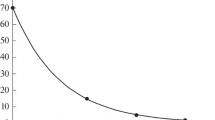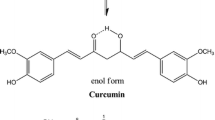Abstract
N-Acetylcysteine and captopril, respectively mucolytic and antihypertensive drugs, contain free sulfhydryl groups. Since in general thiols have well-established radioprotective abilities, we sought putative radioprotective effects of these drugs against therapeutic fast neutrons. We show that pBR322 plasmid DNA is indeed protected against radiolytic strand breakage by both drugs. The oxygen independent protection is consistent with a hydroxyl radical scavenging mechanism. A clonogenicity assay reveals an increase of the survival of SCL-1 cultured keratinocytes irradiated in the presence of the drugs compared with cells irradiated without drugs. Our results suggest possible interferences between treatment with drugs bearing-SH groups and radiotherapy.
Similar content being viewed by others
References
Bagchi D, Prasad R, Das DK (1989) Direct scavenging of free radicals by captopril, an angiotensin converting enzyme inhibitor. Biochem Biophys Res Commun 158:52–57
Biaglow JE, Varnes ME, Clark EP, Epp ER (1983) The role of thiols in cellular response to radiation and drugs. Radiat Res 95:437–455
Blank LE, Haveman J, Zanwijk N (1987) The protective effect ofN-acetylcysteine in thorax irradiation of mice. Radiother Oncol 10:67–69
Bonanoni L, Gazzaniga A (1980) Toxicological, pharmacokinetic and metabolic studies on acetylcysteine. Eur J Respir Dis 61 (suppl 111):45–51
Cerdan D, Grillon C, Monsigny M, Redziniak G, Kieda C (1991) Human keratinocyte membrane lectins: characterization and modulation of their expression by cytokines. Biol Cell 73:35–42
Fahey RC (1988) Protection of DNA by thiols. Pharmacol Ther 39:101–108
Held KD (1988) Models for protection of DNA in cells. Pharmacol Ther 39:123–131
Hoffman MZ, Hayon E (1973) Pulse radiolysis study of sulphhydryl compounds in aqueous solution. J Phys Chem 77:990–996
Howard-Flanders P (1960) Effect of oxygen on the radiosensitivity of bacteriophage in the presence of sulphydryl compounds. Nature 186:485–487
Kim JA, Baker DG, Hahn SS, Goodchild NT, Constable W (1983) Topical use ofN-acetylcysteine for reduction of skin reaction to radiation therapy. Semin Onco 10 [Suppl 1]:86–88
Maniatis TC, Fritsch EF, Sambrook J (1982) Molecular cloning. A laboratory manual. Cold Spring Harbor Laboratory, NY, pp 89–96
Migdaloff BH, Antonaccio MJ, Mc Kinstry DN, Singvi SM, Lan SJ, Egli P, Kripalani KJ (1984) Captopril: pharmacology, metabolism and disposition. Drug Metab Rev 15:841–869
Murray D, Prager A, Vanankeren SC, Altschuler EM, Kerr MS, Terry NHA, Milas L (1990) Comparative effect of the thiols dithiothreitol, cysteamine and WR-151326 on survival and on the induction of DNA damage in cultured Chinese hamster ovary cells exposed to gamma-radiation. Int J Radiat Biol 58:71–91
Rodenstein D, De Coster A, Gazzaniga A (1980) Pharmacokinetics of oral acetylcysteine: absorption, binding and metabolism in patients with respiratory disorders. Eur J Respir Dis 61:59–60
Schwartz JL, Mustafi R, Becket MA, Czyzewski EA, Farhangi E, Grdina DJ, Rotmensch J, Weichselbaum RR (1991) Radiation-induced DNA double-strand break frequencies in human squamous cell carcinoma lines of different radiation sensitivites. Int J Radiat Biol 59:1314–1352
Sigdestad CP, Connor AM, Sims CS (1992) Modification of neutron-induced hematopoetic effects by chemical modifiers. Int J Radiation Oncology Biol Phys 22:807–811
Spotheim-Maurizot M, Franchet J, Sabattier R, Charlier M (1991) DNA radiolysis by fast neutrons. II. Oxygen, thiols and ionic strength effects. Int J Radiat Biol 59:1313–1324
Utley JF, Marlowe C, Waddell WJ (1976) Distribution of35S-labelled WR-2721 in normal and malignant tissues of the mouse. Radiat Res 68:284–291
Ward WF, Molteni A, Ts'o C, Hinz JM (1990) Captopril reduces collagen and mast cell accumulation in irradiated lung. Int J Radiat Oncol Biol Phys 19:1405–1409
Wardman P, Dennis MF, Stratford MRL, White J (1992) Extracellular: intracellular and subcellular concentration gradients of thiols. Int J Radiat Oncol Biol Phys 22:751–754
Yuhas JM, Storer JB (1969) Differential chemoprotection of normal and malignant tissues. J Natl Cancer Inst 42:331–335
Yuhas JM (1980) Active versus passive absorption kinetics as the basis for selective protection of normal tissues byS-2-(3-aminopropylamino)-ethylphosphorothioic acid. Cancer Res 40:1519–1524
Zheng S, Newton GL, Gonock G, Fahey RC, Ward JF (1988) Radioprotection of DNA by thiols: relationship between the net charge on a thiol and its ability to protect DNA. Radiat Res 114:11–27
Author information
Authors and Affiliations
Rights and permissions
About this article
Cite this article
Spotheim-Maurizot, M., Garnier, F., Kieda, C. et al. N-acetylcysteine and captopril protect DNA and cells against radiolysis by fast neutrons. Radiat Environ Biophys 32, 337–343 (1993). https://doi.org/10.1007/BF01225921
Received:
Accepted:
Issue Date:
DOI: https://doi.org/10.1007/BF01225921




